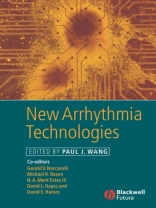New Arrhythmia Technologies provides a complete discussion of recent, emerging, and future arrhythmia technologies.
This forward-thinking book details successful trials and investigates areas of research that have not yet reached the trial phase.
The elite panel of authors have explored fresh information on:
* advances in antiarrhythmic pharmacologis therapy
* advances in monitoring, risk assessment, and noninvasive mapping
* advances in pacing therapy
* advances in implantable defibrillators
* advances in catheter and surgical ablation
* advances in antiarrhythmic biological therapy
* vision for the future of arrhythmia technologies
* web-based defibrillation monitoring.
New Arrhythmia Technologies presents a unique view of the latest in arrhythmia innovations through the eyes of the experts in the field.
Inhoudsopgave
List of Contributors.
Preface.
Section I Advances in Antiarrhythmic Pharmacologic
Therapy.
Chapter 1 New Antiarrhythmic Pharmacologic Therapies and
Regulatory Issues in Antiarrhythmic Drug Development.
Chapter 2 New Frontiers in Antithrombotic Therapy for Atrial
Fibrillation.
.
Section II Future of Antiarrhythmic Therapy.
.
Chapter 3 Principles of Pharmacogenomics: Focus on
Arrhythmias.
Chapter 4The Cardiac Sodium Channel Carboxy Terminus: Predicted
and Detected Structure Provide a Novel Target for Antiarrhythmic
Drug Development.
Chapter 5Embryonic stem cell-derived cardiomyocytes as a model
for arrhythmia.
Chapter 6Gene and Cell Therapy for Sinus and AV Nodal
Dysfunction.
Chapter 7Gene Therapy for Cardiac Tachyarrhythmias.
Section III Monitoring, Noninvasive Mapping, Risk Assessment,
and External Defibrillation.
Chapter 8 New Developments in Noninvasive Rhythm Monitoring,
Implantable Hemodynamic, Monitoring, Functional Status Monitoring
, and Non-Invasive Mapping.
Chapter 9Techniques of Prediction of Arrhythmia Occurrence and
Stratification for Sudden Cardiac Death.
Chapter 10 Beta-blocker Efficacy in Long QT Syndrome Patients
with Mutations in the Pore and Nonpore Regions of the h ERG
Potassium-channel Gene.
Chapter 11 New Developments in Out-of-Hospital Cardiac
Defibrillation.
Section IV Advances in Pacing.
Chapter 12 Sensor and Sensor Algorithms.
Chapter 13New Electrode and Lead Designs for Pacemakers.
Chapter 14Current Concepts in Intravascular Pacemaker and
Defibrillator Lead Extraction.
Chapter 15Left Ventricular Epicardial Lead Implantation:
Anatomy, Techniques, and Tools.
Chapter 16New Resynchronization Lead Systems and Devices.
Chapter 17New Indications for Pacing.
Section V Advances in Implantable Defibrillators.
Chapter 18New Sensing and Discrimination Algorithms.
Chapter 19Arrhythmia Prevention and Termination Algorithms.
Chapter 20New Lead Designs and Lead-Less Systems.
Chapter 21Optimization of Defibrillation Function.
Chapter 22Remote Web-Based Device Monitoring.
Chapter 23New ICD Indications.
Section VI Advances in Catheter and Surgical
Ablation.
Chapter 24Advances in Surgical Ablation Devices for Atrial
Fibrillation.
Chapter 25Epicardial Access.
Chapter 26Advances in Catheter Control Devices.
Chapter 27Advances in Energy Sources in Catheter Ablation.
Chapter 28New Ablation Paradigms: Anatomic Ablation of Complex
Arrhythmia Substrates.
Index
Over de auteur
Dr Paul J Wang is the Director of the Stanford Cardiac Arrhythmia Service and Cardiac Electrophysiology Laboratory. He received his undergraduate degree at Harvard University and his medical degree at Columbia University in New York City. He received his medical residency at Columbia-Presbyterian Medical Center in New York City and completed his cardiovascular training at Brigham and Women’s Hospital.
Dr Wang has co-authored textbooks on implantable defibrillators, sudden cardiac death, and cardiac resynchronization/biventricular pacing therapy and has invented a number of new arrhythmia technologies.
He articipates on numerous national boards and panels in cardiac electrophysiology. He is currently Vice-Chair of the Education Committee of the Heart Rhythm Society. He is co-director of an Advanced Course in Pacemakers, Implantable Defibrillators, and Resynchronization Therapy sponsored by the Heart Rhythm Society. He also serves as a member of the Cardiac Electrophysiology Board Certification Exam Writing Committee of the American Board of Internal Medicine.












